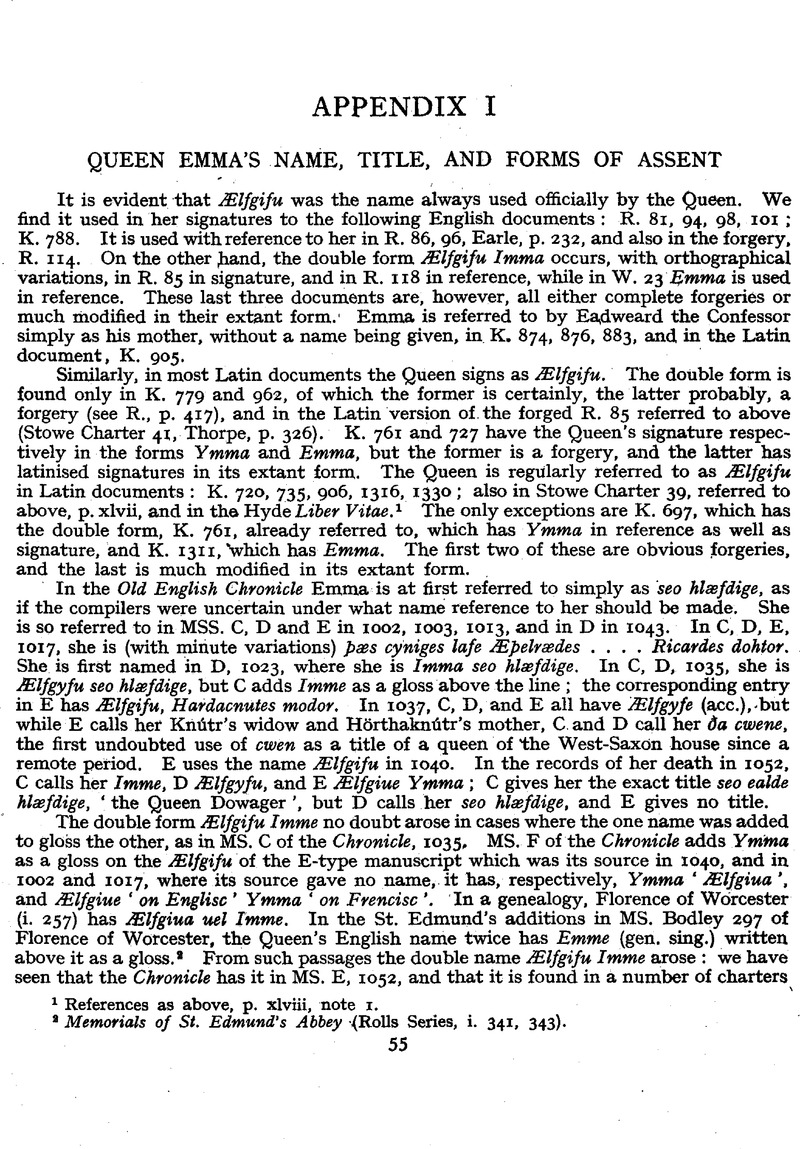No CrossRef data available.
Article contents
Appendix I: Queen Emma's Name, Title, and Forms of Assent
Published online by Cambridge University Press: 24 December 2009
Abstract

- Type
- Appendices
- Information
- Copyright
- Copyright © Royal Historical Society 1949
References
page 55 note 1 References as above, p. xlviii, note 1.
page 55 note 2 Memorials of St. Edmund's Abbey (Rolls Series, i. 341, 343).
page 56 note 1 See below, note 5.
page 56 note 2 Liebermann, Ungedruckte anglo-normannische Geschichtsquellen, p. 274.
page 56 note 3 Rolls Series ed. of Symeon of Durham, ii. 373.
page 56 note 4 These minor chronicles are edited by Liebermann, op. cit., pp. 56 ff.
page 56 note 5 Liebermann, Gesetze, i. 663. Most manuscripts of this text have the double form of the queen's name, the English name appearing in forms more or less assimilated to its Norse equivalent Alfifa (appearing as Alueua, Alfueua, Eluiua), the foreign one as Emma, except in one manuscript, which has Iunia (< Imma). Cf. also above. Liebermann (op. cit., iii. 342; cf. his Über die Leges Edwardi Confessoris, pp. 36–7) mentions as one of the sources of this law-book an unknown sketch of English history from 975 to 1042, and it is obviously from this that the double form is derived. This sketch of history, or one very closely related to it, is a source used by the surving form (thirteenth century) of the Historia Norvegiae and hence we find Emma there referred to as Elfigeua (Storm, p. 123).
page 57 note 1 Except only the Historia Norvegiae, referred to in the preceding note.
page 57 note 2 See Redin, M., Studies on uncompounded personal names in Old English (Uppsala, 1919). p. 67Google Scholar ; also, on the etymology of the name and the reason for the existence of alternative forms with ‘ e ’ and ‘ i ’, Forssner, Th., Continental-Germanic personal names in England (Uppsala, 1916), p. 69Google Scholar.
page 57 note 3 See below, p. 66, note 1.
page 58 note 1 The only instance of cwen so used seems to be Chronicle, D, 946.
page 58 note 2 In B. 972 and 1174, Ælfgifu, wife of Eadwig, and Ælfthryth, wife of Eadgar, sign as þæs cyninges wif, but neither is preserved in a contemporary copy.
page 58 note 3 In the entry for 1017, E has to cwene, while C and D have to wife.
page 58 note 4 On the re-introduction of this title in the time of Ælfthryth, see Stevenson's Assgr, p. 202. It is not found in the tenth century before her time, although it is used occasionally of Eadgifu in late translations and abstracts of documents : B. 766, 823, 881, 1065, 1133.
page 58 note 5 The queen receives the title domina in the Latin version of R. 85 in Stowe Charter 41, but this is a mere isolated literal translation of seo hlæfdige.
page 58 note 6 Printed in the Ordnance Survey Facsimiles, ii, Winchester College, 4, and in the Liber … de Hyda (Rolls Series, pp. 324–6).
page 58 note 7 See above, p. xlvii.
page 59 note 1 Also ia B. 1284, but the signature list of that document seems to be influenced by that of B. 1282.
page 59 note 2 Mr. N. R. Ker kindly confirmed my opinion that these two documents are in one hand.
page 59 note 3 Facsimile of the former in Ordnance Survey Facsimiles, ii, Exeter Cathedral, n ; of the latter in B.M. Facsimiles, iv, 18.
page 59 note 4 See Napier and Stevenson, Crawford Collection, p. 149.
page 59 note 5 Lyfing, who accompanied Knútr to Rome, and became Bishop of Crediton in the same year (Florence of Worcester, ed. Thorpe, i. 185) : there can be no doubt that this was in 1027 (see above, p. lxii), and therefore the date of this charter (1026) must be an error.
page 59 note 6 A very similar formula is used by Knútr in K. 729, which is a very doubtful document, also of western origin.
page 60 note 1 One or two other points show contact between the documents of this group. In all the six documents, the queen signs after the archbishops, a practice otherwise unknown after 1019, cf. below, p. 65. Of the Six documents, four, including the two preserved in contemporary copies, spell the name Ælfgifu with final -0, a spelling found in none of the other documents which name the queen. K. 744 is dated 1031, and, though it is preserved in a fine contemporary copy, it names Earl Hákon among the witnesses, though he was drowned in 1029 or 1030 (see below, p. 72) : this indicates that the document was concocted in the west, following an older model, and did not issue from the court. Of the six documents under discussion, Hákon also signed K. 743. Lastly, it may be noted that, while of the six documents only two are preserved in contemporary copies, and these two are in the same hand, no other two charters of Knútr are in manuscripts by the same scribe; the only other charters of Knútr preserved in copies, which are contemporary or nearly so with the transactions recorded, are Cott. Aug. ii, 24 (= K. 736), Stowe Charters 39 and 42, Ilchester Charter 2 (= K. 741) and Winchester College, Charter 4, and of these no two are in the same hand, or in that of Exeter Cathedral, Charter 11, and Cott. Aug. ii, 69.
page 61 note 1 Napier and Stevenson read consensi.
page 61 note 2 Cf. K. 762, also an Abingdon document.




